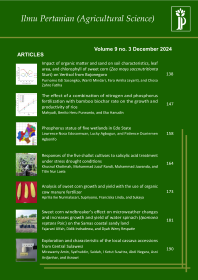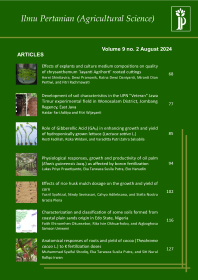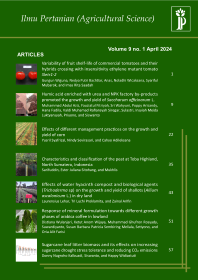
Biochemical Changes of Three Cocoa Clones (Theobroma cacao L.) Under Drought Stress
Fakhrusy Zakariyya(1*), Didik Indradewa(2)
(1) Pusat Penelitian Kopi dan Kakao Indonesia
(2) Faculty of Agriculture, University of Gadjah Mada, Yogyakarta
(*) Corresponding Author
Abstract
Drought stress is a serious threat for cocoa production. One of the plant mechanisms to survive from the drought stress is through producing some biochemical compounds. The objective of this research was to know biochemical changes in three cocoa clones during drought stress. The research was conducted at the green house of Indonesian Coffee and Cocoa Research Institute from January – December 2017. The experiment was designed by using Randomized Complete Block Design (RCBD) with 2 factors and with 3 replications. The first factor was clones of scion that consisting KW 641, Sulawesi 1 and ICS 60 which each of its grafted to Scavina 6 clone as rootstock. The second factor was watering intervals which consisting; every 2 days / regularly watering (adequate of water), every 5 days (moderate drought), and every 8 days (severe drought). The result of this research showed that drought stress decreased chlorophyll content, increased hydrogen peroxide content (ROS), increased the activity of superoxide dismutation (SOD), increased ascorbic acid content, increased total phenolic content, and increased proline content. Sulawesi 1 and KW 641 clones showed lower hydrogen peroxide (ROS) content, while chlorophyll content, SOD activity, total phenolic content, ascorbic acid content, and proline content were higher compared with ICS 60 clone. It showed that Sulawesi 1 and KW 641 clones had more drought-resistance compared with ICS 60 clone.
Keywords
Full Text:
PDFReferences
Abdul-Hafeez, E. Y., N. S. Karamova, O. N. Ilinskaya. 2014. Antioxidant activity and total phenolic compound content of certain medicinal plants. International Journal of Biosciences, 5 (9), 213 – 222.
Ahmad, P., C. A. Jaleel, M. A. Salem, G. Nabi, and S. Sharma. 2010. Roles of enzymatic and nonenzymatic antioxidants in plants during abiotic stress. Crit. Rev. Biotechnol., 30(3), 161-175.
Alban, M. K. A., S. E. Apshara, K.B. Hebbar,T. G. Mathias & A. Sévérin. 2015. Potential of Antioxidant Enzymes in Depicting Drought Tolerance in Cocoa (Theobroma cacao L.) Genotypes at Young Age. African Journal of Science and Research, 4 (5) :18-23
Alban, M., K. A. amd S. E. A. K. B. Hebbar. 2016. Morpho-physiological Criteria for Assessment of Two Month Old Cocoa (Theobroma cacao L.) Genotypes for Drought Tolerance. Indian Journal Plant Physiology, 21(1), 23-30.
Alexieva, V., I. Sergiev, S. Mapelli & E. Karanov. 2001. The effect of drought and ultraviolet radiation on growth and stress markers in pea and wheat. Plant, Cell and Environment, 24, 1337–1344.
Almeida, A. A. F. & Valle, R. R. 2010. Cacao: ecophysiology of growth and production. In: MATTA, F. da (Ed.). Ecophysiology of tropical tree crops. New York: Nova Science Publishers. v.1, p.37‑70.
Babu, D. P. Gurumurthy, S. K. Borra and K. M. Cherian. 2013. Antioxidant and free radical scavenging activity of triphala determined by using different in vitro models. Journal of Medicinal Plant Research, 7(39), pp. 2898-2905.
Bates , L.; R.P. Waldren & R.P.I.D. Teare. 1973. Rapid determination of free proline for water-stress studies. Plant and Soil, 39, pp. 205–207.
Caverzan, A., G. Passaia, S. B. Rosa, C. W. Ribeiro, F. Lazzarotto, and M. Margis-Pinheiro. 2012. Plant responses to stresses: Role of ascorbate peroxidase in the antioxidant protection. Genet. Mol Biol., 35(4), pp. 1011–1019.
Chéour, F., I. Kaddachi, D. Achouri, S. Bannour and L. Zorgui. 2014. Effects of water stress on relative water, chlorophylls and proline contents in barley (Hordeum vulgare L.) leaves. Journal of Agriculture and Veterinary Science, 7(6), pp. 13 – 16.
Davey, M. W., M. Van Montagu, and D. Inze. 2002. Ascorbate Metabolism and Stress. In : Inze, D. and Van Montagu, M., ed., Oxidative Stress in Plants, 1st ed. London : Taylor and Francis, pp. 333 – 363.
Foti, M. C. 2007. Antioxidant properties of phenols. Journal of Pharmacy and Pharmacology 2007, 59, pp. 1673–1685.
Foyer, C.H. and G. Noctor. 2005. Redox homeostasis and antioxidant signaling: A metabolic interface between stress perception and physiological responses. Plant Cell, 17, pp. 1866–1875.
Foyer, C. H. 2002. The Contribution of Photosynthetic Oxygen Metabolism to Oxidative Stress in Plants. In : Inze, D. and Van Montagu, M., ed., Oxidative Stress in Plants, 1st ed. London : Taylor and Francis, pp. 40 – 128.
Hayat, S.,Q., M. N. Alyemeni, A. S. Wani, J. Pichtel, & A. Ahmad. 2012. Role of proline under changing environments. Plant Signal Behav. 7(11): 1456–1466.
ICCO. 2010. Impact of El Niño / La Niña Weather Events on The World Cocoa Economy. One hundred and forty-second meeting London, 13-17 September 2010.
ICCO. 2017. Production of Cocoa Beans. ICCO Quarterly Bulletin of Cocoa Statistic XLIII (3) : 1-2.
Liu, Q.,L. Luo, and L. Zheng. 2018. Lignins: Biosynthesis and Biological Functions in Plants. Int J Mol Sci., 19(2), 335.
Lobo, V., A. Patil, A. Phatak, and N. Chandra. 2010. Free radicals, antioxidants and functional foods: Impact on human health. Pharmacogn Rev. 4(8): 118–126.
Maheshwari, R. and R. S. Dubey. 2009. Nickel-induced oxidative stress and the role of antioxidant defence in rice seedlings. Plant Growth Regulation, 59(1), pp. 37-49.
Marklund, S., Marklund, G. (1974). Involvement of the superoxyde anion radical in the auto oxidation of pyrogallol and a convenient assay for superoxyde dismutase. Eurupian Journal of Biochemistry, 47, 469-474.
Mingyi J., W. Yang, J. Xu, and Q. Chen. 1994. Active oxygen damage effect of chlorophyll degradation in rice seedlings under osmotic stress. Acta Botanica Sinica 36 (4 ) 289 – 295.
Rezaei-Chiyaneh, E., S. M. Seyyedi, E. Ebrahimian, S. S. Moghaddam, and C. A. Damalas. 2018. Exogenous application of gamma-aminobutyric acid (GABA) alleviates the effect of water deficit stress in black cumin (Nigella sativa L.). Industrial Crops & Products, 112, pp. 741–748.
Ryu, H. W., J. H. Lee, J. E. Kang, Y. M. Jin, and K. H. Park. 2012. Inhibition of Xanthine Oxidase by Phenolic Phytochemicals from Broussonetia papyrifera. Journal of Korean Soc. Appl. Biol. Chem., 55, pp. 587-594.
Sade, B., S. Soylu, and E. Soylu. 2011. Drought and oxidative stress. African Journal of Biotechnology 10, 54, pp. 102 – 109.
Saglam, A., N. Saruhan, R. Terzi, and A. Kadioglu. 2011. The Relations between Antioxidant Enzymes and Chlorophyll Fluorescence Parameters in Common Bean Cultivars Differing in Sensitivity to Drought Stress. Russian Journal of Plant Physiology, 58(1), pp. 60–68.
Sakiroh, I. Sobari, & M. Herman. 2015. Teknologi mengurangi dampak perubahan iklim pada kakao di lahan kering. Sirinov, 3(2), pp. 55 – 66.
Santos, I. C., A. F. Almeida, D. Anhert, A. S. Conceciao, C. P. Pirovani, J. L. Pires, R. R. Valle, & V. C. Balligar. 2014. Molecular, Physiological and Biochemical Responses of Theobroma cacao L. Genotypes to Soil Water Deficit. PLoS ONE, 9(12), pp. 1 – 31.
Shevyakova, N. I., E. A. Bakulina, and V. Kuznetsov. 2009. Proline antioxidant role in the common ice plant subjected to salinity and paraquat treatment inducing oxidative stress. Russian Journal of Plant Physiology, 56(5), pp. 663-669.
Sudarmadji, S. 2010. Analisa Bahan Makanan dan Pertanian. Yogyakarta: Penerbit Liberty
Susilo, A. W. 2015 a. KW 641, klon harapan kakao tahan kering. Warta Pusat Penelitian Kopi dan Kakao Indonesia, 27(3) : 1-5.
Soertani, S. & Soenardjan.1984. Pengalaman dalam musim kemarau panjang 1982 di PT. Perkebunan XVIII. Perkebunan Indonesia. 19-28.
Taga, M.S., E.E. Miller and D.E. Pratt. 1984. Chia seeds as a source of natural lipid antioxidants. J. Am. Oil Chem. Soc. 61:928-931
Upadhyaya, H., M. H. Khan, and S. K. Panda. 2007. Hydrogen Peroxide Induces Oxidative Stress in Detached Leaves of Oryza Sativa L. Gen. Appl. Plant Physiology, 33(2), pp. 83 – 95.
Varela, M. C., I. Arslan, M. A. Reginato, A. M. Cenzano, M. V. Luna. 2016. Phenolic compounds as indicators of drought resistance in shrubs from Patagonian shrublands (Argentina). Plant Physiology and Biochemistry, 104, pp. 81 – 91.
Wang, Y., R. Branicky, A. Noë, and S. Hekim. 2018. Superoxide dismutases: Dual roles in controlling ROS damage and regulating ROS signaling. J. Cell Biol., 217(6), pp.1915-1928.
Winaryo, A. Iswanto, dan H. Winarno. 1997. Kajian Penggunaan Tegangan Osmotik dan Kerapatan Stomata sebagai Kriteria Seleksi Klon Kakao Tahan Cekaman Air. Pelita Perkebunan 13(2): 63-70.
Zakariyya, F., B. Setiyawan, and A. W. Susilo. 2016. Stomatal, Proline, and Leaf Water Status Characters of Some Cocoa Clones (Theobroma cacao L.) on Prolonged Dry Season. Pelita Perkebunan 33 (1), pp. 109-117.
Zanneti, L. V. , C. R. D. Milanez, V. N. Gama, M. A. G. Aguilar, C. A. S. Souza, E. Campostrini, T. M. Ferraz, & F. A. M. M. A. Figueiredo. 2016. Leaf application of silicon in young cacao plants subjected to water deficit. Pesq. agropec. bras., 51(3), pp. 215-223.
Article Metrics
Refbacks
- There are currently no refbacks.
Ilmu Pertanian (Agricultural Science) ISSN 0126-4214 (print), ISSN 2527-7162 (online) is published by Faculty of Agriculture Universitas Gadjah Mada collaboration with Perhimpunan Sarjana Pertanian Indonesia (PISPI) and licensed under a Creative Commons Attribution-ShareAlike 4.0 International License.














